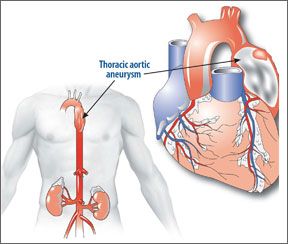Like other cardiovascular problems, such as hypertension, an aortic aneurysm can develop without symptoms, yet develop a potentially fatal consequence. An estimated 15,000 Americans die annually from a ruptured aortic aneurysm-an abnormal bulge or ballooning in the wall of an artery. The events are considered the 10th leading cause of death among men older than 50 in the U.S. While most aortic aneurysms form in the abdomen, about one-fourth of them develop in the thorax or chest. But new procedures are helping to save lives and improve recovery times for patients who must be treated for a thoracic aortic aneurysms (TAA). A minimally invasive surgical technique, requiring a small incision instead of an open-heart procedure-which was the standard until recently-can allow surgeons to relieve the pressure of the aneurysm with devices that can help keep blood from flowing to the aneurysm. An endovascular stent graft is a small, flexible fabric tube supported by metal mesh that is inserted with a catheter into the aorta so that it extends above and below the aneurysm. A tight seal is formed to keep blood away from the diseased part of the aorta, which often shrinks over time with the reduction in pressure. "This procedure carries the advantages of less pain, less blood usage and quicker recovery, apart from the cosmetic advantages (over open-heart surgery)," says Cleveland Clinic cardiac surgeon Lars Svensson, MD. "For the aorta beyond the artery to the left arm, many of these can be repaired with stent grafts and wont require the chest to be opened," Dr. Svensson says.
To continue reading this article or issue you must be a paid subscriber.
Sign in






